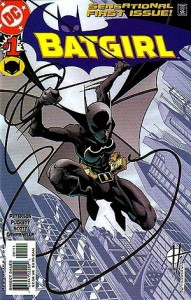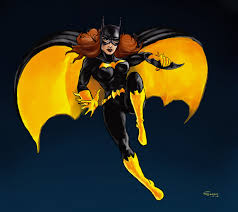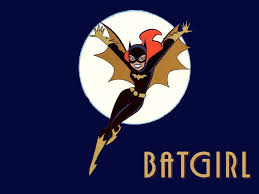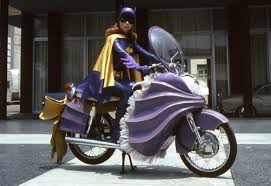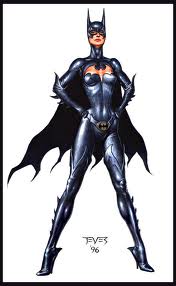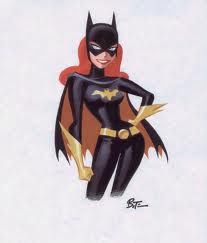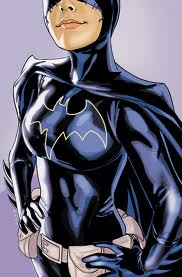Batgirl
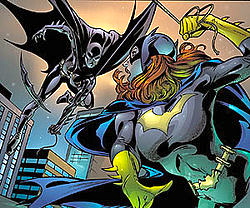
Batman: Batgirl meets Catwoman
First meeting between Batgirl (Barbara Gordon / Oracle) and Catwoman (Selina Kyle) from the episode “Batgirl Retuns” from Batman: The Animated Series. Guest-starring Robin (Dick Grayson / Nightwing).
Art from Wizard Magazine (2006), featuring Barbara Gordon and Cassandra Cain as Batgirl. Art by Matt Haley and David Hahn.
Batgirl is the name of several fictional characters appearing in comic bookspublished by DC Comics, depicted as female counterparts to the superheroBatman. Although the character Betty Kane was introduced into publication in 1961 by Bill Finger and Sheldon Moldoff as Bat-Girl, she is replaced by Barbara Gordon in 1967, who later came to be identified as the iconic Batgirl. Her creation came about as a joint project between DC Comics editor Julius Schwartz and the producers of the 1960s Batman television series. In order to boost ratings for the third season of Batman, the producers requested a new female character be introduced into publication that could be adapted into the television series. At Schwartz’s direction, Barbara Gordon debuted in Detective Comics #359 titled, “The Million Dollar Debut of Batgirl!” (1967) by writer Gardner Fox and artistCarmine Infantino. Depicted as the daughter of Gotham City police commissionerJames Gordon, her civilian identity is given a doctorate in library science and she is employed as head of Gotham City Public Library, as well as later being elected to the United States Congress. As Batgirl, the character operates primarily in Gotham City, allying herself with Batman and the original Robin Dick Grayson, as well as other prominent heroes in the DC Universe.
While the introduction of Batgirl into the Batman television series failed to save it from cancellation, her comic book counterpart gained popularity and makes regular appearances in Detective Comics, Batman Family and several other books produced by DC until 1988. That year, she appears in Barbara Kesel‘sBatgirl Special #1, in which she retires from crime-fighting. She subsequently appears in Alan Moore‘s graphic novel Batman: The Killing Joke where, in her civilian identity, she is shot through the spinal cord by the Joker and left paraplegic. Although she is recreated as the computer expert and information broker Oracle by editor Kim Yale and writer John Ostrander the following year, her paralysis sparked debate about the portrayal of women in comics, particularly violence depicted toward female characters. Despite her paralysis in mainstream continuity, alternative versions of Barbara Gordon in her Batgirl persona have continued to appear in non-canon storylines produced by DC, typically under the company’s imprint labels, Elseworlds and All Star DC Comics.
Batgirl #1 (April 2000) Featuring the Cassandra Cain version of the character. Art by Damion Scott.
In the 1999 crossover No Man’s Land, the character Helena Bertinelli, known asHuntress, briefly assumes the role of Batgirl until she is stripped of the identity by Batman for violating his stringent codes. Within the same storyline, writer Kelley Puckett and artist Damion Scott introduce the character Cassandra Cain, who takes the mantle of Batgirl under the guidance of Batman and Oracle. Written as the daughter of assassins David Cain and Lady Shiva, she is trained from early childhood to read human body language instead of developing verbal and written communication skills as part of her father’s conditioning to mold her into the world’s deadliest assassin. However, after committing her first murder, she vows to never again use her martial arts prowess to kill. In 2000, she became the first Batgirl to star in an eponymous monthly comic book series as well as one of the most prominent characters of Asian descent to appear in American comics. The series was canceled in 2006, at which point during the company-wide event One Year Later, she is established as a villain and head of the League of Assassins. After receiving harsh feedback from readership, she is later restored to her original conception. However, the character Stephanie Brown, originally known as Spoiler and later Robin, succeeds her as Batgirl after Cassandra Cain abandons the role.
Stephanie Brown became the featured character of the Batgirl series written byBryan Q. Miller from 2009 to 2011. DC subsequently relaunched all their monthly publications during The New 52 event. In the revised continuity, Barbara Gordon recovers from her paralysis following a surgical procedure and stars in the relaunched Batgirl series written by Gail Simone as the title character. As Batgirl, Barbara Gordon has been adapted into various media relating to the Batman franchise, including television, film, animation, video games, and other merchandise. This factored into the decision to return her to the comic book role, as Dan DiDio, Co-Publisher of DC Comics, expressed that she is the best known version of the character. In 2011, she was ranked 17th in both Comics Buyer’s Guide‘s “100 Sexiest Women in Comics” and IGN‘s “Top 100 Comic Books Heroes.”
Detective Comics, Batman Family and other appearances (1967-1988)
Following the accusations of a homoerotic subtext in the depiction of the relationship between Batman and Robin as described inFredric Wertham‘s book Seduction of the Innocent (1954), a female character, Kathy Kane the Batwoman, appeared in 1956 as alove-interest for Batman. In 1961 DC Comics introduced a second female character as a love-interest for Robin. Betty Kane as “Bat-Girl” arrived as the niece of and Robin-like sidekick to Batwoman, first appearing in Batman #139 (1961). The creation of the Batman Family, which included Batman and Batwoman depicted as parents, Robin and Bat-Girl depicted as their children, the extraterrestrial imp Bat-Mite and the “family pet” Ace the Bat-Hound, caused the Batman-related comic books to take “a wrong turn, switching from superheroes to situational comedy.”
DC Comics abandoned these characters in 1964 when newly-appointed Batman-editor Julius Schwartz judged them too silly and therefore inappropriate. Schwartz had asserted that these characters should be removed, considering the Batman related comic books had steadily declined in sales, and restored the Batman mythology to its original conception of heroic vigilantism. Bat-Girl, along with other characters in the Batman Family, were retconned out of existence following the 1985 limited series Crisis on Infinite Earths. However, even though Bat-Girl did not exist in the post-Crisis continuity, a modified version of the character, Mary Elizabeth “Bette” Kane, introduced as the superhero Flamebird, continues to appear in DC Comics publications.
Schwartz stated that he had been asked to develop a new female character in order to attract a female viewership to the Batmantelevision series of the 1960’s. When producers William Dozier and Howie Horowitz saw rough concept artwork of the new Batgirl by artist Carmine Infantino during a visit to DC offices, they optioned the character in a bid to help sell a third season to the ABCtelevision network. Infantino reflected on the creation of Batgirl, stating “Bob Kane had had a Bat-Girl for about three stories in the ’50’s but she had nothing to do with a bat. She was like a pesky girl version of Robin. I knew we could do a lot better, so Julie and I came up with the real Batgirl, who was so popular she almost got her own TV show.” Yvonne Craig portrayed the character in the show’s third season. Barbara Gordon and alter ego Batgirl debuted in Detective Comics #359, “The Million Dollar Debut of Batgirl” (1967), as the daughter of Gotham City’s Police Commissioner James Gordon. In the debut story, while driving to a costume ball dressed as a female version of Batman, Barbara Gordon intervenes in a kidnapping attempt on Bruce Wayne by the super villain Killer Moth, attracting Batman’s attention and leading to a crime-fighting career. Although Batman insists she give up crime-fighting because of her gender, Batgirl disregards his objections.
In her civilian identity, Dr. Barbara Gordon Ph.D. is depicted as a career woman with a doctorate in library science, as well as being head of Gotham City public library, “presumably one of the largest public libraries in the DC Comics version of reality.” Barbara Gordon’s Batgirl exceeded the earlier Bat-Girl and Batwoman characters in popularity, and readers requested for her to appear in other titles. Although some readers requested that Batwoman also continue to appear in publication, DC responded to the fan-based acclaim and criticism of the new character in an open letter in Detective Comics #417 (1971), stating: “I’d like to say a few words about the reaction some readers have to Batgirl. These are readers who remember Batwoman and the other Bat-girls from years back … They were there because romance seemed to be needed in Batman’s life. But thanks to the big change and a foresighted editor, these hapless females are gone for good. In their place stands a girl who is a capable crime-fighter, a far cry from Batwoman who constantly had to be rescued [by] Batman.”
Batgirl continued to appear in DC Comics publications throughout the late 1960s and 1970s as a supporting character in Detective Comics, in addition to guest appearances in various titles such as Justice League of America, World’s Finest Comics, The Brave and the Bold,[16] Adventure Comics, and Superman. In the mid-1970’s Batgirl reveals her secret identity to her father (who had already discovered it on his own) and serves as a member of the United States House of Representatives. She moves toWashington, D.C., intending to give up her career as Batgirl, and in June 1972 appeared in a story entitled “Batgirl’s Last Case. Julius Schwartz brought her back a year later in Superman #268 (1973) in which she has a blind date with Clark Kent, establishing their friendship, and fights alongside Superman. Batgirl and Superman team up twice more, in Superman #279 and DC Comics Presents #19. Batgirl also guest-starred in other Superman related titles such as #453 of Adventure Comics and in Superman Family #171, where she teams with Supergirl. The character is given a starring role in DC’s Batman Family comic book which debuted in 1975. The original Robin Dick Grayson became her partner in the series, with the two frequently referred to as the “Dynamite Duo: Batgirl & Robin”. Batgirl meets Batwoman in Batman Family #10, when the retired superhero briefly returns to crime-fighting (before the Bronze Tiger murders Kane). The two fight Killer Moth and Cavalier, and learn each other’s secret identities. Batwoman retires once again at the conclusion of the story, leaving Batgirl to continue crime-fighting. Although this series ended after three years of publication, Batgirl continued to appear in back up stories published in Detective Comicsthrough issue #519 (October 1982).
Crisis on Infinite Earths, a limited miniseries published in 1985, was written in order to reduce the complex history of DC Comics to a single continuity. Although Batgirl is a featured character, her role is relatively small—she delivers Supergirl’s eulogy in issue seven of the 12-part series. The conclusion of Crisis on Infinite Earths changed DC Universe continuity in many ways. Following the reboot, Barbara Gordon is born to Roger and Thelma Gordon, and she is Jim Gordon’s niece and adopted daughter in current canon. Post-Crisis, Supergirl does not arrive on Earth until after Gordon has established herself as Oracle, and many of the adventures she shared with Batgirl are retroactively described as having been experienced by Power Girl. In Secret Origins #20 (1987), Barbara Gordon’s origin is rebooted by author Barbara Randal. Within the storyline, Gordon recounts the series of events that lead to her career as Batgirl, including her first encounter with Batman as a child, studying martial arts under the tutelage of a sensei, memorizing maps and blue prints of the city, excelling in academics in order to skip grades, and pushing herself to become a star athlete.
Batgirl Special and Batman: The Killing Joke (1988)
DC officially retired the hero in the one-shot comic Batgirl Special #1 (July 1988), written by Barbara Kesel. Later that year, she appears in Alan Moore’s Batman: The Killing Joke. In this graphic novel, the Joker shoots and paralyzes Barbara Gordon in an attempt to drive her father insane, thereby proving to Batman that anyone can be morally compromised. Although events in The Killing Joke exert a great impact on the character, the story has little to do with her. She is deployed as a plot device to cement the Joker’s vendetta against Commissioner Gordon and Batman. In 2006, during an interview with Wizard, Moore expressed regret over his treatment of the character calling it “shallow and ill-conceived.” He stated prior to writing the graphic novel, “I asked DC if they had any problem with me crippling Barbara Gordon—who was Batgirl at the time—and if I remember, I spoke to Len Wein, who was our editor on the project,” and following a discussion with then-Executive Editorial Director Dick Giordano, “Len got back onto the phone and said, ‘Yeah, okay, cripple the bitch.'” Although there has been speculation as to whether or not editors at DC specifically intended to have the character’s paralysis become permanent, Brian Cronin, author of Was Superman A Spy?: And Other Comic Book Legends Revealed (2009) noted that DC had hired Barbara Kesel to write the Batgirl Special specifically to retire the character and set her in place for The Killing Joke. Gail Simone included the character’s paralysis in a list of “major female characters that had been killed, mutilated, and depowered”, dubbing the phenomenon “Women in Refrigerators” in reference to a 1994 Green Lantern story where the title character discovers his girlfriend’s mutilated body in his refrigerator. Following the release of the graphic novel, comic book editor and writer Kim Yale discussed how distasteful she found the treatment of Barbara Gordon with her husband, fellow comic writer John Ostrander. Rather than allow the character to fall into obscurity, the two decided to revive her as a character living with a disability—the information broker, Oracle.
No Man’s Land (1999)
Eleven years after the editorial retirement of Barbara Gordon as Batgirl, a new version of the character was introduced in Batman: Shadow of the Bat #83 during the multi-title story arc “No Man’s Land” (1999). In Batman: Legends of the Dark Knight #120 (1999), the new Batgirl is revealed to be Helena Bertinelli, an established DC comics superhero alternatively known as the Huntress. Bertinelli is eventually forced to abandon the mantle by Batgirl. No Man’s Land also marks the introduction of Cassandra Cain in Batman #567 (1999). Depicted as a martial arts child prodigy, Cassandra Cain is written as a young woman of partly Asian descent who succeeds Helena Bertinelli as Batgirl, with the approval of both Batman and Oracle.
Batgirl and other appearances (2000-2011)
The first Batgirl monthly comic was published in 2000, with Cassandra Cain as the title character. Raised by assassin David Cain, Cassandra Cain was not taught spoken language, but instead was taught to “read” physical movement. Subsequently, Cain’s only form of communication was body language. The parts of the character’s brain normally used for speech were trained so Cain could read other people’s body language and predict, with uncanny accuracy, their next move. This also caused her brain to develop learning functions different from most, a form of dyslexia that hampers her abilities to read and write.
Despite Cain’s disability, author Andersen Gabrych describes the character’s unique form of language as the key factor in what makes Cain an excellent detective; the ability to walk into a room and “know” something is wrong based on body language. During the first arc of the Batgirl comic book series entitled “Silent Running”, Cassandra Cain encounters a psychic who “reprograms” her brain, enabling her to comprehend verbal language, while simultaneously losing the ability to predict movements. This issue is resolved during the second arc of the series, “A Knight Alone”, when Batgirl encounters the assassin Lady Shiva who agrees to teach her how to predict movement once again. Six years after its debut, DC Comics canceled theBatgirl comic book series with issue #73 (2006), ending with Cain relinquishing her role as Batgirl.
When DC Comics continuity skipped forward one year after the events of the limited series Infinite Crisis, Cassandra Cain is revived as leader of the League of Assassins, having abandoned her previous characterization as an altruist. The character’s progression from hero to villain angered some of her fans and was accompanied by heavy criticism. Cain reprised her role as Batgirl in the “Titans East” (2007) storyline of Teen Titans, where it was discovered that she had been influenced by a mind-altering drug administered by supervillain Deathstroke the Terminator. Following the conclusion of the storyline, DC Comics has restored Cain’s original characterization as a superhero and the character has been given a supporting role in the comic book series Batman and the Outsiders.
Following the events of Batman’s disappearance, Cassandra, acting under her mentor’s orders in the event of his death, handed over the Batgirl mantle to Stephanie Brown, the former Spoiler and Robin. After declining an offer from Tim Drake to reclaim the Batgirl mantle from Stephanie, Cassandra rejoined the Batman Family under the new identity of Blackbat. She currently acts as the Hong Kong representative of Batman Inc.
Stephanie Brown, formerly the Spoiler and briefly the fourth Robin, takes up the mantle of Batgirl after Cassandra Cain gives Brown her costume under Batman’s order. Eventually, Barbara Gordon approves of Brown as her newest successor — and she gives Brown her own Batgirl costume and becomes her mentor for a period. Brown is the fourth in-continuity Batgirl and the second Batgirl to star in her own ongoing Batgirl comic book series.
The New 52: Batgirl, Birds of Prey and other appearances (2011-present)
In September, 2011, following the company-wide relaunch, Barbara Gordon stars in a new Batgirl series—one of The New 52 titles featuring the company’s most iconic characters. The conclusion of the limited series Flashpoint (2011) establishes a new continuity within the DC Universe, with all characters regressing to an earlier age and stage in their careers, while remaining in a modern timeline. DC Senior VP of Sales, Bob Wayne, explained that with each of their titles reverting to issue #1, “our creative teams have the ability to take a more modern approach—not only with each character, but with how the characters interact with one another and the universe as a whole, and focus on the earlier part of the careers of each of our iconic characters.” Wayne also stated that “The Killing Joke still happened and she was Oracle. Now she will go through physical rehabilitation and become a more seasoned and nuanced character because she had these incredible and diverse experiences. Dan DiDio, Co-Publisher of DC Comics explained the decision by stating that “she’ll always be the most recognizable [Batgirl].” Series writer Gail Simone stated: “For many years, I got to write the character as Oracle, and there is to this day, no character who means more to me. This is classic Barbara as she was originally conceived, with a few big surprises. It’s a bit of a shock, to be sure, but we’re doing everything we can to be respectful to this character’s amazing legacy, while presenting something thrilling that a generation of comics readers will be experiencing for the first time … Barbara Gordon leaping, fighting, and swinging over Gotham. Now, when citizens of that city look up, they are going to see BATGIRL. And that is absolutely thrilling.”
In the new, revised continuity, the events of The Killing Joke took place three years before the current storyline, and while it is established she was paraplegic during that time, Barbara Gordon is written as having regained her mobility after undergoing experimental surgery at a South African clinic. Although she resumes her work as Batgirl one year after her recovery, she continues to suffer from posttraumatic stress disorder, causing her to hesitate in battle when exposed to gunfire that could result in receiving new spinal damage. The character also exhibits survivor guilt due to the fact she has made a full recovery from her paralysis while others have not. Series writer Gail Simone stated that while the character is “one of the smartest and toughest women in comics … One thing the book is truly about, is that the after-effects of something like PTSD (post-traumatic stress disorder) or other trauma-related syndromes, can strike even very smart, very intellectually tough people, even soldiers and cops”, a subject that is generally overlooked in comic books. She also explained the method of the character’s recovery is based upon real life experiences in that “some of the best real world work in the field of mobility rehabilitation is coming from South Africa. People have been talking about this as if it’s some sort of mystical thing like returning from the dead, but there are treatments and surgeries that can restore mobility in some cases. Barbara’s spine was not severed. That makes her a candidate.”
Prior to release, Batgirl #1 sold out at the distribution level with over 100,000 copies printed in its first run according to Diamond Comic Distributors. Along with Action Comics #1, Justice League #1, Batman #1, Batman and Robin #1, Batman: The Dark Knight#1, Detective Comics #1, Flash #1, Green Lantern #1, and Superman #1, retailers were required to order a second printing. Calvin Reid of Publishers Weekly states in a review of the first issue: “The artwork is okay though conventional, while Simone’s script tries to tie up of the end of the previous Barbara Gordon/Oracle storyline and setup up the new Batgirl. Her formula: murderous villains, blood splattering violence and high flying superheroics mixed with single-white-female bonding … plus a cliffhanger ending to the first issue that offers a nifty [segue] into the new world of Barbara Gordon and Batgirl.” The New York Times critic George Gene Gustines wrote: “Unlike some of the other DC comics I read this week, Batgirl achieves a deft hat trick: a well-shaped reintroduction to a character, an elegant acknowledgement of fundamental history and the establishment of a new status quo. This is a must-buy series.” Earning a B+ rating in a review from Entertainment Weekly, Ken Tucker writes that Simone “[takes] her Birds of Prey storytelling powers and focuses them on the newly revived Barbara Gordon as Batgirl. The result is a burst of exhilaration, as Barbara/Batgirl revels in her new freedom even as she encounters a so-far not-terribly-chilling villain called Mirror.”
Since the series relaunch in September 2011, Batgirl has remained within the top 30 of the 300 best-selling monthly comic book publications sold in North America. Monthly estimated sales figures are as follows: Batgirl No. 1 with 81,489 copies (ranked 12th overall), Batgirl No. 2 with 75,227 (ranked 14th), Batgirl No. 3 with 62,974 (ranked 18th), Batgirl No. 4 with 53,975 (raked 23rd), Batgirl No. 5 with 51,327 (raked 26th), and Batgirl No. 6 with 47,836 (raked 30th). The hardcover edition of volume 1, Batgirl: The Darkest Reflection, which collects issues #1-6, made the The New York Times Best Seller list, alongside Animal Man: The Hunt, Batman & Robin: Born to Kill, Batman: Detective Comics, Wonder Woman: Blood, Batwoman: Hydrology, Green Lantern: Sinestro.
Additionally, Barbara Gordon makes an appearance in Birds of Prey No. 1, where Black Canary offers her a spot on the new Birds of Prey roster. She declines Canary’s invitation, suggesting that Katana take her place instead. Series writer Duane Swierczynski has stated that Batgirl will join the team in issue #4. He commented that while she “is an essential part of this team”, she is not the focus of the series, as she is hesitant to be associated with the other characters because of their status as outlaws.


